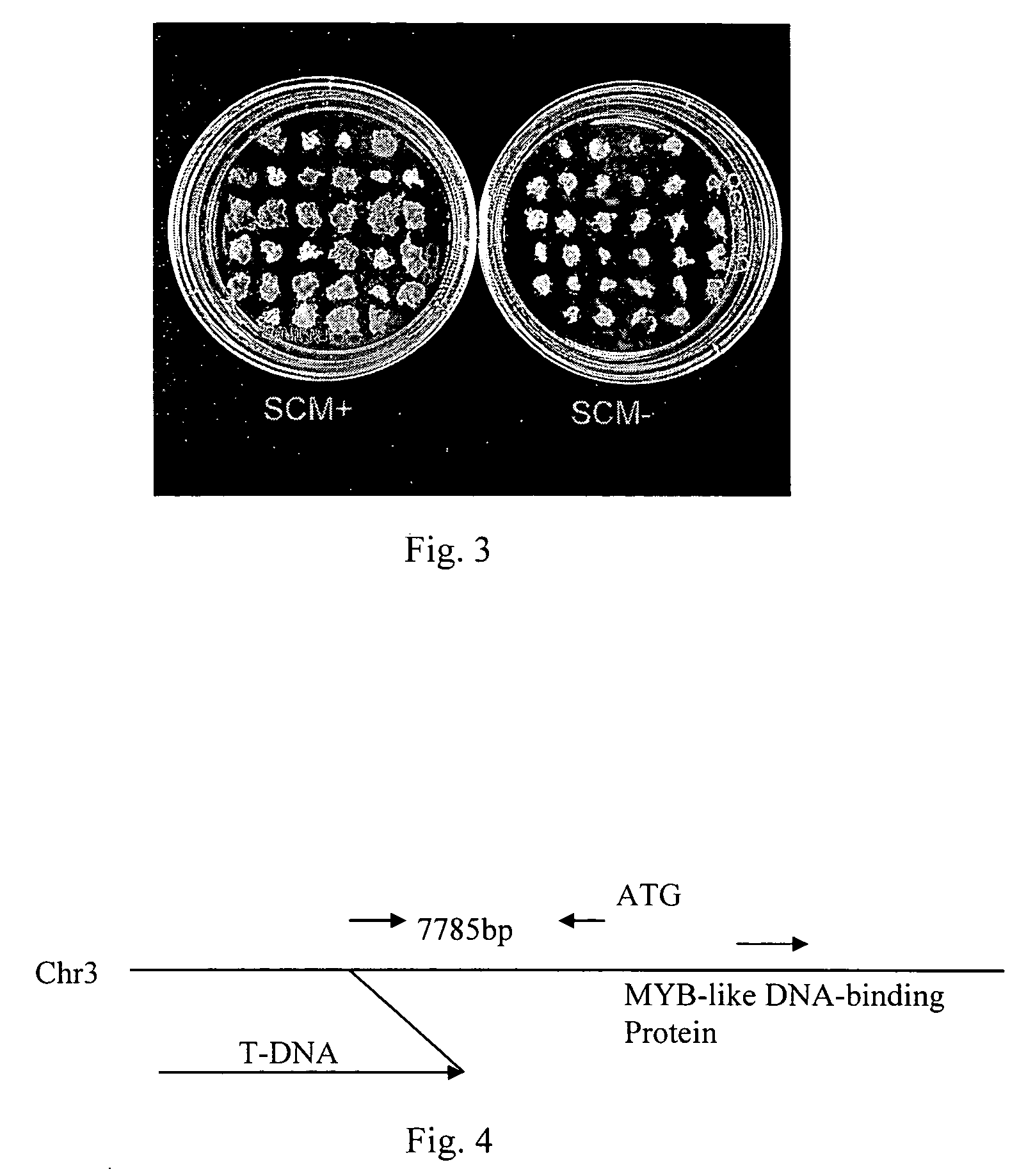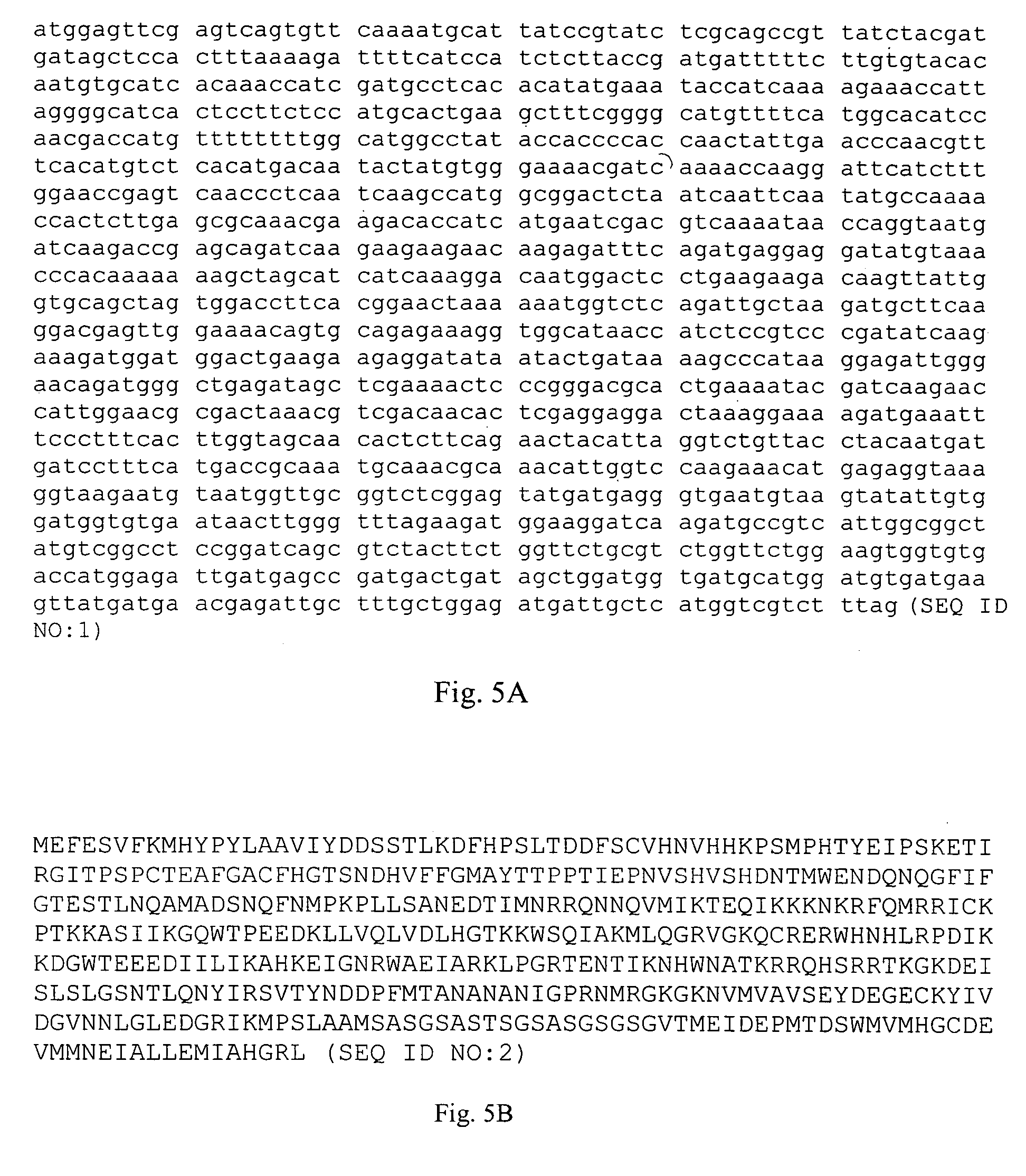Promotion of somatic embryogenesis in plants by PGA37 gene expression
a technology of somatic embryogenesis and gene expression, which is applied in the field of promotion of somatic embryogenesis in plants by pga37 gene expression, can solve the problems of severe abnormal plant growth and development, little is known about the signal transduction pathway, and the fate of embryo-like structures remains unknown
- Summary
- Abstract
- Description
- Claims
- Application Information
AI Technical Summary
Benefits of technology
Problems solved by technology
Method used
Image
Examples
example 1
Plant Materials, Growth Conditions and Plant Transformation
[0050]The Wassilewskija, Columbia and Landsberg ecotypes of A. thaliana were used. Plants were grown under continuous white light at 22° C. on solid A medium (1×MS salts (Murashige and Skoog, 1962), 3% sucrose, 0.8% agar) supplemented with appropriate antibiotics and / or the inducer 17-β-estradiol (10 uM). In planta transformation of Arabidopsis plants (the Columbia ecotype) was performed as described by Bechtold et al. (1993). Transformation of root explants was carried out according to Koncz et al. (1989).
example 2
Molecular Manipulations
[0051]Molecular manipulations were performed as specifically stated or by the methods as taught by Sambrook et al. (1989). The XVE inducible expression vector pER10 is identical to pER8 (Zuo et al., 2000a) except that the hygromycin selectable marker of pER8 was replaced with a kanamycin selectable marker. To construct the mutagenesis vector pER16, pER10 was digested with SpeI and Asp718I followed by Klenow enzyme fill-in reaction and religation. The resulting pER16 vector lacked the rbcsS3A polyA addition sequence of the OLexA−46::T3A expression cassette (Zuo et al. (2000a)).
[0052]pER16 is shown in FIG. 1. Only the region between the Right Border (RB) and Left Border (LB) is shown (not to scale). Two transcription units and the OLexA−46 promoter are located between the RB and LB. In the first transcription unit, the G10-90 promoter (Ishige et al., 1999) drives the XVE fusion gene terminated by the rbcs E9 polyA addition sequence. The second transcription unit...
example 3
Screening of pga Mutants
[0056]Explants derived from Arabidopsis vegetative tissues are known to be incapable of forming somatic embryos or embryogenic calli promoted by external plant hormones. We presumed that external hormones alone were incapable of activating key regulators of Arabidopsis necessary for vegetative-to-embryogenesis transition. With appropriate hormone treatments, gain-of-function mutations in these regulatory genes may activate the vegetative-to-embryonic transition. Such gain-of-function mutations, on the other hand, may also cause severe defects during subsequent plant growth and development. Therefore, if the expression of the mutated gene and / or the biological activity of related gene products is not appropriately controlled, it will be difficult to maintain the identified mutations. An example is the constitutive overexpression of the LEC1 gene (Lotan et al., 1998). As a consequence, we carried out the screen by using a previously developed chemical-inducible...
PUM
| Property | Measurement | Unit |
|---|---|---|
| nucleic acid | aaaaa | aaaaa |
| concentrations | aaaaa | aaaaa |
| chemical- | aaaaa | aaaaa |
Abstract
Description
Claims
Application Information
 Login to View More
Login to View More - R&D
- Intellectual Property
- Life Sciences
- Materials
- Tech Scout
- Unparalleled Data Quality
- Higher Quality Content
- 60% Fewer Hallucinations
Browse by: Latest US Patents, China's latest patents, Technical Efficacy Thesaurus, Application Domain, Technology Topic, Popular Technical Reports.
© 2025 PatSnap. All rights reserved.Legal|Privacy policy|Modern Slavery Act Transparency Statement|Sitemap|About US| Contact US: help@patsnap.com



